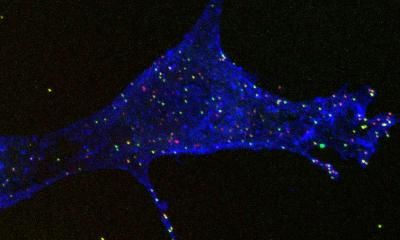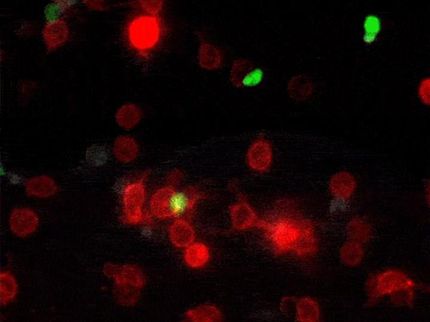Mechanism of dengue virus entry into cells
dengue fever, an infectious tropical disease caused by a mosquito-borne virus, afflicts millions of people each year, causing fever, headache, muscle and joint pains and a characteristic skin rash. In some people the disease progresses to a severe, often fatal, form known as dengue hemorrhagic fever. Despite its heavy toll, the prevention and clinical treatment of dengue infection has been a "dramatic failure in public health compared to other infectious diseases like HIV," said Ping Liu of the University of North Carolina at Chapel Hill.

How dengue virus enters cells of our immune system: a 3D projection of a cell expressing on its surface DC-SIGN (stained in blue with antibodies) that have captured many dengue viruses (in green or green combined with red) and internalized dengue viruses (shown only in red).
P.Liu/UNC
Specifically, Liu, a postdoctoral scholar in the laboratories of cell biologist Ken Jacobson and biophysical chemist Nancy Thompson, along with dengue fever expert Aravinda de Silva, used high-resolution microscopes to examine the expression of a particular protein, known as DC-SIGN (for dendritic cell-specific intercellular adhesion molecule-grabbing nonintegrin), on the surface of immune system cells called dendritic cells.
The normal role of DC-SIGN is to capture pathogens so that fragments of those pathogens can be presented as antigens on the surface of the dendritic cells. Such antigens then are recognized by T cells -- the workhorse cells of the immune system -- "which is one of the first steps in the normal immune response," Liu said.
While it has been known for some time that dengue used DC-SIGN to attach to cells, Liu and her colleagues used high-resolution microscopy to study exactly how the viruses used the protein to gain entry into cells. "DC-SIGN has a unique carbohydrate recognition domain on its extracellular portion, which binds to all sorts of carbohydrates on pathogens," she explained. (Other pathogens, including HIV and the bacterium that causes tuberculosis, are likely to use the same back door).
"An effective medication or vaccine should stop the process of dengue virus entry into cells," Liu said. To that end, she said, de Silva and his colleagues have identified strong neutralization antibodies that block dengue infection. "We are looking into the details of how those neutralization antibodies act and the role of DC-SIGN in the neutralization process."
By identifying the mechanism of antibody neutralization, Liu and colleagues hope to advance the development of vaccines for Dengue virus infections.
Most read news
Topics
Organizations
Other news from the department science

Get the analytics and lab tech industry in your inbox
By submitting this form you agree that LUMITOS AG will send you the newsletter(s) selected above by email. Your data will not be passed on to third parties. Your data will be stored and processed in accordance with our data protection regulations. LUMITOS may contact you by email for the purpose of advertising or market and opinion surveys. You can revoke your consent at any time without giving reasons to LUMITOS AG, Ernst-Augustin-Str. 2, 12489 Berlin, Germany or by e-mail at revoke@lumitos.com with effect for the future. In addition, each email contains a link to unsubscribe from the corresponding newsletter.


























































